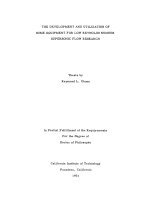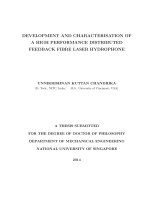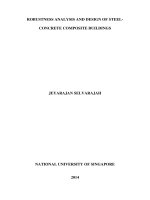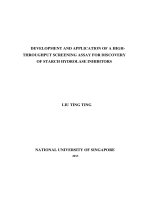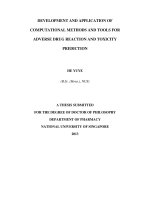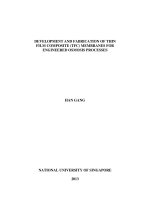Development and fabrication of thin film composite (TFC) membranes for engineered osmosis processes
Bạn đang xem bản rút gọn của tài liệu. Xem và tải ngay bản đầy đủ của tài liệu tại đây (7.23 MB, 261 trang )
DEVELOPMENT AND FABRICATION OF THIN
FILM COMPOSITE (TFC) MEMBRANES FOR
ENGINEERED OSMOSIS PROCESSES
HAN GANG
NATIONAL UNIVERSITY OF SINGAPORE
2013
DEVELOPMENT AND FABRICATION OF THIN
FILM COMPOSITE (TFC) MEMBRANES FOR
ENGINEERED OSMOSIS PROCESSES
HAN GANG
(B.Sci.(Hons.),Dalian University of Technology, China)
A THESIS SUBMITTED
FOR THE DEGREE OF DOCTOR OF
PHILOSOPHY
DEPARTMENT OF CHEMICAL AND
BIOMOLECULAR ENGINEERING
NATIONAL UNIVERSITY OF SINGAPORE
2013
DECLARATION
I hereby declare that this dissertation is my original work and it has been
written by me in its entirety. I have duly acknowledged all the sources of
information which have been used in the dissertation.
This dissertation has also not been submitted for any degree in any university
previously.
HAN GANG
Han Gang
Digitally signed by Han Gang
DN: cn=Han Gang, o=NUS, ou=NUS,
email=, c=US
Date: 2014.04.24 17:43:49 +08'00'
i
ACKNOWLEDGEMENT
My PhD study and this dissertation would not have been finished without the
help from these kind people who in one way or another contributed their
invaluable assistance in the progress and completion of this study.
First and foremost, I would like to express my deepest gratitude and
appreciation to my supervisor Prof. Chung Tai-Shung (Neal) who offered me
an opportunity into this fascinating area of membrane research. His consistent
guidance, enthusiastic encouragement and support throughout my PhD study
are invaluable. From him, I have learned and benefited greatly in not only
research knowledge but also what qualifies a researcher.
I also would like to express my sincere appreciation to my PhD thesis
committee members, Prof. Lu Xianmao, Prof. Hong Liang, and Prof. Isabel C.
Escobar. Their suggestions on my PhD thesis have been constructive and
invaluable.
I would like to gratefully acknowledge the research scholarship offered by the
National University of Singapore (NUS), Singapore. NUS and the Department
of Chemical and Biomolecular Engineering provided me good facilities and
professional atmosphere for conducting study and research.
I also wish to express my recognition to Singapore National Research
Foundation (NRF) (grant number: R-279-000-336-281; NUS grant number:
ii
C279-000-019-101), and the Singapore National Research Foundation under
its Environmental & Water Technologies Strategic Research Programme and
administered by the Environment & Water Industry Programme Office (EWI)
of PUB under the project entitled “Membrane development for osmotic power
generation, Part 1. Materials development and membrane fabrication” (1102-
IRIS-11-01) and NUS grant number of R-279-000-381-279 for their financial
support; as well as the Mitsui Chemical company for providing the polymer
materials.
I also would like to convey my appreciation to all my cheerful research group
members who have made my study at NUS colorful and memorable. Especial
thanks are given to Dr. Zhang Sui,
Dr. Li Xue, Dr. Su Jincai, Dr. Natalia
Widjojo, Dr. Panu Sukitpaneenit, Dr. Sun Shipeng, Dr. Wang Honglei, Dr.
Chen Hangzheng, Dr. Wang Kaiyu,
Mrs. Ong Ruichin, and Miss. Zhong
Peishan f
or their kind help and invaluable suggestions on my research work.
My sincere thanks also go to all staff members in the Department of Chemical
and Biomolecular Engineering who have helped me in material purchasing,
characterization techniques and professional suggestions. Special appreciation
is also extended to the postgraduate committee, department head Prof. Lee
Jimyang and the lab officers, Mrs. Lin Hueyyi, Mr. Sim Yihui, and Miss Fu
Xiuzhu for their kind help and supports.
iii
Last but not least, I must express my gratefulness to my families and my
lovely girlfriend for their unconditional love and support, without them I
cannot complete my PhD study.
iv
TABLE OF CONTENTS
ACKNOWLEDGEMENT i
TABLE OF CONTENTS iv
SUMMARY xi
A LIST OF TABLES xv
A LIST OF FIGURES xvii
CHAPTER 1 INTRODUCTION AND BACKGROUND 1
1.1 Water and Energy Crisis 1
1.2 Membrane Technologies for Water Production 2
1.3 Membrane Technologies for Power Generation 3
Reference 5
CHAPTER 2 ENGINEERED OSMOSIS PROCESSES FOR WATER
AND ENERGY PRODUCTION 7
2.1 The Classifications of Engineered Osmosis Processes 7
2.2 Forward Osmosis (FO) 10
2.2.1 Applications of FO 11
2.2.1.1 Desalination 11
2.2.1.2 Wastewater Treatment and Osmotic Membrane Bioreactor
(OMBR) 13
2.2.1.3 Liquid Food and Pharmaceutical Applications 15
2.2.1.4 Other Applications 16
2.3 Pressure Retarded Osmosis (PRO) for Osmotic Power Generation 16
v
2.3.1 Theoretical Potential of Salinity Gradient Energy 17
2.3.2 Principle of Pressure Retarded Osmosis (PRO) 20
2.4 Challenges in Engineered Osmosis Processes 23
2.4.1 Concentration Polarization in Engineered Osmosis Processes 23
2.4.2 Development of Draw Solution 26
2.4.3 Membrane Fouling in Engineered Osmosis Processes 28
2.4.3.1 Membrane Fouling in FO 29
2.4.3.2 Membrane Fouling in PRO 31
2.4.4 Membrane Development for Engineered Osmosis Processes 32
2.4.4.1 Membranes for FO 33
2.4.4.2 Membranes for PRO 40
Reference 46
CHAPTER 3 MEMBRANE FABRICATION FOR ENGINEERED
OSMOSIS PROCESSES 61
3.1 Design and Engineering Principles for Polymeric Membranes 61
3.1.1 Phase Inversion Induced Membranes 62
3.1.2 Thin Film Composite (TFC) Membranes 65
3.2 Membrane Structures and Configurations 68
3.2.1 Symmetric and Asymmetric Membranes 68
3.2.2 Flat-Sheet Membranes 69
3.2.3 Hollow Fiber Membranes 71
Reference 76
vi
CHAPTER 4 MASS TRANSPORT IN ENGINEERED OSMOSIS
PROCESSES 79
4.1 Mass Transport Mechanism in Engineered Osmosis Processes 79
4.2 The Water Flux and Reverse Salt Flux in Forward Osmosis (FO) 82
4.3 The Water Flux, Reverse Salt Flux and Power Density in Pressure
Retarded Osmosis (PRO) 86
Reference 89
CHAPTER 5 EXPERIMENTAL AND METHODS 91
5.1 Materials 91
5.2 Spectroscopic Characterizations 92
5.2.1 Field Emission Scanning Electronic Microscopy (FESEM) 92
5.2.2 Atomic Force Microscope (AFM) 93
5.2.3 X-ray Photoelectron Spectroscopy (XPS) 93
5.2.4 Fourier Transform Infrared Spectroscopy (FTIR) 93
5.3 Beam Positron Annihilation Lifetime Spectroscopy (PALS) 93
5.4 Forward Osmosis (FO) and Pressure Retarded Osmosis (PRO) Tests 95
5.4.1 FO Performance Tests 95
5.4.2 Lab-Scale PRO Experimental Setup 97
5.4.3 PRO Performance Tests 98
5.5 Other Characterizations 99
5.5.1 Thermogravimetric Analysis (TGA) 99
5.5.2 Ion Exchange Capacity (IEC) 99
vii
5.5.3 Membrane Mechanical Strengths 99
5.5.4 Water Contact Angle 100
5.5.5 Membrane Porosity 100
5.5.6 Pore Size and Pore Size Distribution of Membrane Supports 101
5.5.7 Pure Water Permeability, Salt Rejection and Salt Permeability Tests
102
Reference 104
CHAPTER 6 THIN FILM COMPOSITE FORWARD OSMOSIS
MEMBRANES BASED ON POLYDOPAMINE MODIFIED
POLYSULFONE SUBSTRATES WITH ENHANCEMENTS IN BOTH
WATER FLUX AND SALT REJECTION 107
6.1 Introduction 107
6.2 Experimental 111
6.2.1 Preparation of Polysulfone (PSf) Membrane Substrates 111
6.2.2 Modification of PSf Membrane Substrates with Polydopamine 111
6.2.3 Fabrication of TFC-FO Membranes by Interfacial Polymerization
112
6.3 Results and Discussion 112
6.3.1 Structure and Morphology of Membrane Substrates 112
6.3.2 Formation and Characterization of the Polydopamine (PDA)
Coating Layer 117
6.3.3 Characteristics of the TFC-FO Membranes 120
viii
6.3.4 Desalination Performance of the TFC-FO Membranes 124
6.4 Summary 127
Reference 129
CHAPTER 7 THIN FILM COMPOSITE FORWARD OSMOSIS
MEMBRANES WITH NOVEL HYDROPHILIC SUPPORTS FOR
DESALINATION 136
7.1 Introduction 136
7.2 Experimental 140
7.2.1 Synthesis of Sulphonated Poly(ether ketone) (SPEK) Polymer 140
7.2.2 Preparation of the Membrane Substrates 141
7.2.3 Fabrication of the TFC-FO Membranes 142
7.3 Results and Discussion 142
7.3.1 Characterization of the Synthesized SPEK Polymer 142
7.3.2 Characteristics and Performance of the Membrane Substrates 144
7.3.2.1 Effects of the Membrane Substrate Structures 144
7.3.2.2 Effects of the Sulphonated Material Blending Concentrations
147
7.3.3 Characteristics and Performance of the TFC-FO Membranes 150
7.3.3.1 Effects of the Thermal Post-treatment 150
7.3.3.2 Effects of the Sulphonated Material Concentrations 156
7.3.4 Osmotic Seawater Desalination 160
7.4 Summary 160
ix
Reference 163
CHAPTER 8 HIGH PERFORMANCE THIN FILM COMPOSITE
PRESSURE RETARDED OSMOSIS (PRO) MEMBRANES FOR
RENEWABLE SALINITY-GRADIENT ENERGY GENERATION 172
8.1 Introduction 172
8.2 Experimental 175
8.2.1 Preparation of the Polyamide TFC-PRO Membranes 175
8.2.2 Modification of the TFC-PRO Membranes 176
8.3 Results and Discussion 177
8.3.1 Characteristics of the Matrimid Membrane Support 177
8.3.2 Characteristics of the TFC-PRO Membranes 183
8.3.3 Effects of Post-treatment on TFC-PRO Membranes 188
8.3.4 Osmotic Power Generation 192
8.4 Summary 197
Reference 198
CHAPTER 9 HIGHLY ROBUST THIN-FILM COMPOSITE
PRESSURE RETARDED OSMOSIS (PRO) HOLLOW FIBER
MEMBRANES WITH HIGH POWER DENSITIES FOR RENEWABLE
SALINITY-GRADIENT ENERGY GENERATION 204
9.1 Introduction 204
9.2 Experimental 207
9.2.1 Fabrication of Hollow Fiber Supports 207
x
9.2.2 Interfacial Polymerization of TFC-PRO Hollow Fiber Membranes
209
9.3 Results and Discussion 210
9.3.1 Characteristics of the Hollow Fiber Supports 210
9.3.2 Characteristics of TFC-PRO Hollow Fiber Membranes 217
9.3.3 Implications of Developed TFC-PRO Hollow Fibers for Osmotic
Power Generation 219
9.4 Summary 224
Reference 226
CHAPTER 10 RECOMMENDATIN AND FUTURE WORK 231
10.1 Forward Osmosis (FO) 231
10.2 Pressure Retarded Osmosis (PRO) 233
A LIST OF PUBLICATIONS 235
xi
SUMMARY
Engineered osmosis processes have gained rapid interest in recent years and
they may become a potential solution for the world’s most challenging
problems of water and energy scarcity. The concept of utilizing osmotic
pressure difference between two water streams across semipermeable
membranes has been explored for several decades, however, lack of optimal
membranes still hinders competition between forward osmosis (FO) and
pressure retarded osmosis (PRO) with existing water purification and power
generation technologies, respectively.
Thin film composite (TFC) membranes consisting of an aromatic polyamide
selective skin and a customized microporous support possess high water
permeability and salt rejection. Another promising advantage of the TFC
membranes is that the specific features of each individual layer can be tailored
independently to achieve the desired characteristics and separation
performance. However, traditional TFC membranes are made for hydraulic-
pressure-driven separation processes, and they are suffered from severe
internal concentration polarization and thus have low water permeation flux in
engineered osmosis processes. Effective TFC osmotic membranes with
desirable structure and performance are strongly desired to further advance the
FO and PRO technologies. The objectives of this dissertation were to develop
novel materials and fabrication methods for preparing effective FO
membranes for clean water production and PRO membranes for renewable
osmotic energy generation, as well as to reveal the structure-property
xii
relationships of materials, membrane formation mechanism, membrane
morphology, membrane configuration, and membrane treatments.
In the first part of the work, novel TFC-FO membranes with improved water
flux (J
w
) and lowered salt leakage (J
s
) were developed by employing a
hydrophilic polymer polydopamine (PDA) to modify the hydrophobic
polysulfone supports. PDA modification played a positive role in the
formation of effective TFC-FO membranes, which was realized by producing
a hydrophilic and smooth surface with smaller surface pores and narrower
pore size distribution for the interfacial polymerization reaction, as well as
improving the hydrophilicity of the pore wall inside the support. A high J
w
/J
s
of about 20 L/g was achieved by using a 2 M NaCl as the draw solution and
deionized water as the feed solution in a testing configuration where the
membrane active layer faced the draw solution.
In order to further improve the performance of the TFC-FO membranes, a
novel sulphonated poly(etherketone) (SPEK) material with super-hydrophilic
nature was molecularly designed as the substrate material. It was found that
blending certain SPEK material into the hydrophobic membrane substrate not
only help form a fully sponge-like structure, but also could effectively enhance
the membrane hydrophilicity and reduce the membrane structure parameter.
Therefore the detrimental effects of internal concentration polarization could
be significantly reduced. The best TFC-FO membranes showed a water flux of
50 LMH against deionized water and 22 LMH against the 3.5 wt% NaCl
model solution, respectively, when using 2 M NaCl as the draw solution. To
xiii
the best of our knowledge, this seawater desalination performance is the best
one in the reported literatures.
The practical application of PRO technology for harvesting the renewable
osmotic energy is encumbered by the absence of effective membranes. Most
conventional osmotic membranes are designed for no- or low-pressure
operation environments and are likely to be damaged under high pressure
conditions in PRO. The design strategies of TFC membranes for PRO
applications are dramatically different from those for FO. A more stringent
requirement on membrane robust strength is essential for PRO membranes. In
this work, novel TFC-PRO membranes were successfully developed as a
continuous effort in fabricating TFC-FO membranes. The newly developed
TFC-PRO membranes not only exhibited an excellent water permeability (A =
5.3 L m
-2
h
-1
bar
-1
) and membrane robustness, but also overcame the
bottlenecks of low power density. Under the lab-scale PRO power generation
tests, the membranes could withstand trans-membrane hydraulic pressures up
to 15 bar and achieve a power density ranging from 7 to 12 W/m
2
using
various pre-prepared seawater and brine as draw solutions. The newly
developed PRO membranes consist of an interfacially formed polyamide
selective layer and a customized porous polyimide membrane support. The
polyimide support was tailored to possess a fully sponge-like structure with a
small structure parameter and excellent mechanical robustness, while the
polyamide selective skin was chemically modified to get the desired water
permeability using novel post-fabrication procedures.
xiv
Compared to flat-sheet membranes, hollow fiber membranes are of great
interest due to their high packing density and spacer-free module fabrication.
However, the fabrication of effective PRO hollow fiber membranes is very
difficult and is still in its early stages. In the last part of this dissertation,
highly robust TFC-PRO hollow fiber membranes with high power densities
were successfully developed for osmotic power generation. These newly
developed TFC-PRO membranes consist of a selective polyamide skin formed
on the lumen side of the well-constructed Matrimid
®
hollow fiber supports via
interfacial polymerization. For the first time, the newly developed PRO hollow
fiber membranes could withstand a trans-membrane pressures up to 16 bar and
exhibited a peak power density as high as 14 W/m
2
using seawater brine as the
draw solution and deionized water as the feed. The newly developed TFC
hollow fiber membranes show great capability for producing osmotic energy
via PRO processes.
xv
A LIST OF TABLES
Table 3.1. Summary of the interfacial polymerization variables 68
Table 6.1. Summary of mean effective pore size (d
p
), PWP and MWCO of
substrate membranes. 115
Table 6.2. Surface roughness of PSf and PDA@PSf substrate membranes. . 116
Table 6.3. A Comparison of weight percentages of various elements in
PDA@PSf substrates measured by XPS. 119
Table 6.4. Surface roughness of TFC-FO membranes. 122
Table 6.5. Transport properties and structural parameters of TFC-FO
membranes. 125
Table 7.1. Compositions of casting solutions for the fabrication of membrane
substrates. 141
Table 7.2. Summary of the mean effective pore size (µ
p
), PWP and MWCO of
the PSU/SPEK (50 wt% SPEK) membrane substrates cast from solutions
with/without DEG additive. 145
Table 7.3. PRO and FO performance of the TFC-FO membranes formed on
the PSU/SPEK (50 wt% SPEK) membrane substrates cast from solutions
with/without DEG additive. 146
Table 7.4. Summary of mean effective pore size (µ
p
), PWP and MWCO of
membrane substrates cast from solutions with different SPEK concentrations.
149
Table 7.5. Mechanical properties of membrane substrates cast from solutions
with different SPEK concentrations and thermal treatments. 150
Table 7.6. Effects of thermal treatment on FO performance of TFC
membranes made from different substrates. 151
Table 7.7. Summary of mean effective pore size (µ
p
), PWP and MWCO of the
PSU/SPEK (50 wt% SPEK) membrane substrates with/without thermal
treatment. 153
Table 7.8. Performance of TFC-FO membranes with different SPEK content
in the membrane substrates. 158
Table 7.9. Transport properties and structural parameters of TFC-FO
membranes with different SPEK content in membrane substrates. 159
xvi
Table 8.1. Summary of the mean effective pore size (µ
p
), PWP and MWCO of
the hand-cast Matrimid
®
support membrane before and after being pressurized
at 15bar for 120 min. 181
Table 8.2. Comparison of the mechanical properties of the membranes. 182
Table 8.3. Characteristics of the pristine TFC membrane. 187
Table 8.4. Summary of the synthetic water sources for PRO tests. 192
Table 9.1. Spinning conditions of hollow fiber membrane supports. 208
Table 9.2. Summary of the mean effective pore size (μ
p
), PWP, MWCO,
porosity, water contact angle and dimension of the prepared hollow fiber
supports. 212
Table 9.3. Mechanical properties of the hollow fiber supports. 216
Table 9.4. Transport properties and structural parameters of TFC-PRO hollow
fiber membranes. 217
Table 9.5. FO performance of TFC-PRO hollow fiber membranes. 219
Table 9.6. Summary of the synthetic water sources for PRO tests. 220
Table 9.7. Comparison of the PRO membrane performance. 224
xvii
A LIST OF FIGURES
Figure 1.1 Global water-use by region (a), and world consumption of primary
energy by energy type (b) [2]. 1
Figure 2.1 Comparison of the FO, PRO and RO processes. 7
Figure 2.2 The number of publications on pressure retarded osmosis, forward
osmosis and reverse osmosis from 1950 until 2012. 9
Figure 2.3 Schematic diagram of a typical FO desalination process. 12
Figure 2.4 The mixing of a saltwater and a freshwater to a brackish solution.17
Figure 2.5 Water flux direction and energy consumption/production in FO,
PRO and RO processes [6,49]. 21
Figure 2.6 Schematic drawing of a PRO osmotic power generation plant. 21
Figure 2.7 Illustration of driving force for an asymmetric membrane in FO: (a)
the draw solution against the selective layer (PRO mode); (b) the draw
solution against the porous support layer (FO mode). 24
Figure 2.8 Illustration of the membrane fouling in FO process under different
operating mode, (A) fouling in PRO mode, and (B) fouling in FO mode. 29
Figure 2.9 Cross section SEM micrograph of the commercially available HTI
membrane. 34
Figure 3.1 Typical ternary phase diagram of a polymer-solvent-nonsovlent
system. 64
Figure 3.2 Schematic of the interfacial polymerization procedure. 66
Figure 3.3 Illustration of the membrane formation using the reaction between
diamines and diacid chloride. 67
Figure 3.4 Illustration of a lab-scale membrane casting process. 70
Figure 3.5 Illustration of a continuous flat-sheet membrane casting process. . 71
Figure 3.6 Schematic diagram of hollow fiber spinning line. 72
Figure 3.7 Schematic diagram of area nearby the spinneret and the formation
of nascent hollow fiber during phase inversion. 73
Figure 4.1 Illustration of the pore flow and solution diffusion mechanisms in
the membranes. 80
xviii
Figure 5.1 An illustration of the chemical structure of (a) polysulfone (PSU);
(b) synthesized sulphonated poly(ether ketone) (SPEK); and (c) Matrimid
®
5218 polymer. 92
Figure 5.2 Schematic diagram of the lab-scale PRO setup for flat-sheet
membranes (left) and hollow fiber membranes (right). 97
Figure 6.1 Preparation procedure of polyamide (PA) TFC-FO membrane by
interfacial polymerization reaction on PDA modified PSf substrates. 110
Figure 6.2 Water contact angle of PDA@PSf substrates varied with PDA
coating time. 113
Figure 6.3 FESEM images of substrate surface and cross-section morphology:
(a) PSf; (b) PDA@PSf-1h; (c) PDA@PSf-3h; (d) PDA@PSf-5h. 113
Figure 6.4 Cumulative pore size distribution curves of PSf and PDA@PSf
substrate membranes. 114
Figure 6.5 AFM images of (a) PSf, and (b) PDA@PSf-1h, (c) PDA@PSf-3h,
and (d) PDA@PSf-5h substrate membranes. 116
Figure 6.6 XPS spectra of PSf and PDA@PSf substrate membranes. 117
Figure 6.7 C1s XPS spectra of (a) pristine PSf substrate and (b) PDA@PSf-5h
substrate, and O1s XPS spectra of (c) pristine PSf substrate and (d)
PDA@PSf-5h substrate membrane. 118
Figure 6.8 ATR-FTIR spectra of PSf substrate and PDA@PSf-5h substrate
membranes. 119
Figure 6.9 FESEM images of TFC-FO membranes fabricated on PSf and
PDA@PSf substrate membranes. 120
Figure 6.10 ATR-FTIR spectra of TFC-FO membrane fabricated on PSf and
PDA@PSf-5h substrate membranes. 121
Figure 6.11 N1s XPS spectra of (a) PDA@PSf-5h; and (b) TMC-PDA@PSf-
5h substrate membrane. 123
Figure 6.12 N1s XPS spectra of PSf TFC-FO membrane and PDA@PSf-5h
TFC-FO membrane. 123
Figure 6.13 Water permeation flux and reverse salt flux through TFC-FO
membranes using 2M NaCl as draw solution and deionized water as feed
solution under PRO and FO modes. 125
Figure 6.14 The water fluxes and salt leakages of the PDA@PSf-1h TFC-FO
membrane tested in the FO and PRO modes with varying draw solution
concentrations (NaCl) using deionized water as the feed. 126
xix
Figure 6.15 The water flux in the PRO and FO tests with varying draw
solution concentrations (NaCl) using seawater concentration (3.5 wt% NaCl)
as feed. 127
Figure 7.1 The chemical structure of (a) polysulfone (PSU); (b) SPEK with a
DS=10 wt%. 141
Figure 7.2 Scheme of the interfacial polymerization reaction to form the
polyamide layer. 142
Figure 7.3 TGA curves (a); and FTIR spectra of PSU and synthesized SPEK
polymer (b) 143
Figure 7.4 Pore-size distribution of the PSU/SPEK (50 wt% SPEK) membrane
substrates with/without DEG additive. 145
Figure 7.5 Typical morphology of membrane substrates cast from solutions 1
and 2. 146
Figure 7.6 Typical substrate morphology as a function of SPEK concentration
in substrates for TFC fabrication: (a) casting solution 4 (0 wt% SPEK); (b)
casting solution 3 (25 wt% SPEK); (c) casting solution 2 (50 wt% SPEK). . 147
Figure 7.7 Pore size distributions of membrane substrates with different SPEK
concentrations. 148
Figure 7.8 Pore-size distributions of PSU/SPEK (50 wt% SPEK) membrane
substrates with/without thermal treatment. 152
Figure 7.9 Scheme of the possible pathways for the formation of a sulfone
linkage. 154
Figure 7.10 FTIR spectra of the membrane substrates cast from solution 2 (50
wt% SPEK) with/without thermal treatment. 154
Figure 7.11 TGA curves of the membrane substrates cast from solution 2 (50
wt% SPEK) with/without thermal treatment. 155
Figure 7.12 Typical morphology of TFC-FO membranes with different SPEK
concentrations in the substrates: (a) casting solution 4 (0 wt% SPEK); (b)
casting solution 3 (25 wt% SPEK); (c) casting solution 2 (50 wt% SPEK). . 156
Figure 7.13 The water fluxes and salt leakages of TFC-FO membranes (50
wt% SPEK polymer in the membrane substrates) in the PRO and FO tests with
different draw solution concentrations using deionized water as feed. 159
Figure 7.14 The water flux in the PRO and FO tests with varying draw
solution concentrations (NaCl) using seawater (3.5 wt% NaCl) as feed. 160
xx
Figure 8.1 The chemical structure of (a) Matrimid
®
; (b) polyamide formed by
interfacial polymerization. 176
Figure 8.2 Illustration of the post-treatment procedures for TFC membranes.
177
Figure 8.3 SEM images of (a) PAN membrane support before and after being
pressurized at 15bar for 120 min, and (b) PAN TFC membrane before and
after being tested at 15 bar. 178
Figure 8.4 The variations of normalized pure water permeability (PWP,
LMH/bar) of the Matrimid
®
and PAN supports vs. time at 15 bar. 179
Figure 8.5 SEM images of the hand-cast Matrimid
®
membrane support before
and after being pressurized at 15bar for 120 min. 180
Figure 8.6 Cumulative pore size distribution curves of the hand-cast
Matrimid
®
support before and after being pressurized at 15bar for 120 min.181
Figure 8.7 SEM images of the fabricated TFC membranes (i.e., TFC200)
before and after being tested at 15bar in the PRO process. 183
Figure 8.8 ATR-FTIR spectra of TFC and TFC200 membranes 184
Figure 8.9 AFM images of TFC200 and referential PAN TFC membranes
before and after being tested at 15bar in the PRO process. 186
Figure 8.10 Pure water permeation flux and salt (NaCl) rejection of the
pristine TFC membrane as a function of feed hydraulic pressure using a 200
ppm NaCl solution as the feed at 25 ˚C. 187
Figure 8.11 Transport properties (A and B) of TFC and TFC200 and TFC600
membranes. All tests were done at 1-4 bar using a 200 ppm NaCl solution and
a membrane area of 19.5 cm
2
. 188
Figure 8.12 Water permeation flux and reverse salt flux of TFC and TFC200
and TFC600 membranes using 1M NaCl as the draw solution and deionized
water as the feed solution under PRO. 189
Figure 8.13 Variations of S parameter as a function of position incident energy
for TFC and TFC200 membranes. (Dots: experimental data, lines: fitted
curves via VEPFIT fitting) 191
Figure 8.14 Power densities of TFC, TFC200 and TFC600 membranes vs.
trans-membrane pressure. (Draw solution: seawater brine (1M NaCl), feed
solution: deionized water, and temperature: 25 ˚C). 193
Figure 8.15 (a) Variations of normalized pure water permeability (PWP,
LMH/bar) tested at 15 bar against the initial values for TFC and TFC200 and
TFC600 membranes and (b) variations of salt rejection (NaCl) before and after
xxi
being pressurized at 15 bar. (Rejection tests: at 4 bar using a 200 ppm NaCl
solution and the membrane area of 19.5 cm
2
). 194
Figure 8.16 (a) Power density of the TFC200 membrane as a function of NaCl
concentration; (b) hysteretic study of power density. (Draw solutions:
synthetic seawater brine (1M NaCl) and synthetic seawater (0.59 M NaCl),
feed solution: deionized water and temperature: 25 ˚C). 195
Figure 8.17 Power density of the TFC200 membrane vs. trans-membrane
pressure. (Draw solution: synthetic seawater brine (1M NaCl), feed solution:
varying from synthetic river water to synthetic waste water brine and
concentrated water brine, and temperature: 25 ˚C). 196
Figure 9.1 The control of the phase inversion process with the aid of (a) dope-
solvent co-extrusion technology employing a dual-layer spinneret [32]; and (b)
dual-bath coagulation technology using a single-layer spinneret [36]. 207
Figure 9.2 Schematic diagram of the interfacial polymerization process. 209
Figure 9.3 Typical morphology of the developed hollow fiber supports with
different conditions. 211
Figure 9.4 FESEM micrographs of different bulk and surface morphologies of
HF-1 hollow fiber supports. 212
Figure 9.5 SEM micrographs of different bulk and surface morphologies of
HF-3 hollow fiber supports. 213
Figure 9.6 Pore size distribution of as-spun hollow fiber membrane supports
prepared from different conditions. 214
Figure 9.7 (a) Variations of the normalized pure water permeability (PWP) as
a function of hydraulic pressure; and (b) the “critical pressure” of the hollow
fiber supports. 215
Figure 9.8 Typical morphology of the TFC-PRO hollow fiber membranes. . 217
Figure 9.9 Power density of the developed TFC-PRO hollow fiber membranes
with seawater brine (1M NaCl) as draw solution, and fresh water as feed
solution. 220
Figure 9.10 Schematic of membrane expansion of the TFC-PRO hollow fiber
membranes during PRO operations. 222
Figure 9.11 Power density of the TFC-HF3 PRO hollow fiber membranes with
seawater brine (1M NaCl) as draw solution, and river water and waste water
brine was feed solutions. 223
1
CHAPTER 1 INTRODUCTION AND BACKGROUND
1.1 Water and Energy Crisis
Nowadays, inadequate access to water and energy has become one of the most
pervasive global problems due to the rapid increase in consumption and
depletion in their reserves. Population growth and the expansion of urban &
industrial areas and the increase of living standards further stress the problems
of water and energy crisis [1]. However, an enormous increase in the global
demand for clean water and energy is projected in the near future, as shown in
Fig. 1.1 [2,3]. Adequate water supply and affordable energy sources are
becoming in every country to sustain public health and national prosperity.
Figure 1.1 Global water-uses by region (a), and world consumption of primary
energy by energy type (b) [2].
Clean water is essential to human survival and is important to the global
economy for its uses in agricultural irrigation, industrial processes, oil and gas
exploration, and electricity production [4]. However, their supply is far less
than the actual demand. Today over one-third of the world’s population face
clean water shortage and 2.6 billion people lack adequate sanitation [1,5]. The
severe water shortage has called out for a large number of scientists to pay
more attention to water sustainability and put forth efforts to explore more
